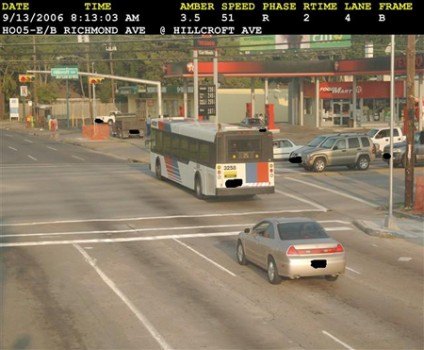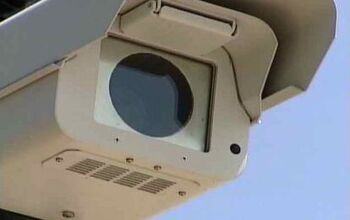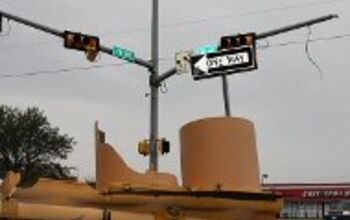Accidents Double at Houston Red Light Camera Locations
Accidents more than doubled at the Houston, Texas intersections where red light cameras are installed, according to a study released Monday by Rice University and the Texas Transportation Institute (TTI). This result posed a dilemma for TTI and the city of Houston which had requested the study. Houston Mayor Bill White was furious when he saw the report’s draft text in August. He banned the document from publication and ordered a re-writing of the text that would reflect a more positive result. To accomplish this task, White was able to turn to the study’s primary author, Rice University Urban Politics Professor Robert Stein. Stein’s wife, Marty, is employed by the city of Houston as a top aide to the mayor. Stein’s newly revised report now concludes that “red light cameras are mitigating a general, more severe increase in collisions.”
That left the Texas Transportation Institute with its own difficulty. Last month TTI coauthored another study with the Texas Department of Transportation (TxDOT) intended to support photo enforcement on a statewide basis. This report drew its conclusions from an examination of 56 intersections, 31 of which were found in Houston. The TxDOT-TTI study received wide publicity for the reported claim that red light cameras reduced accidents at camera intersections by 30 percent.
“The TxDOT-TTI results are impossible to square with Houston’s results,” Houston attorney Randall L. Kallinen told TheNewspaper.
Kallinen and attorney Paul Kubosh have filed a lawsuit to force Houston to disclose the August draft of the Rice-TTI study under state freedom of information laws. Publicity over the lawsuit likely forced the city finally to release the final report during a holiday week. The revised report’s data tell a much different story than that presented in the conclusions.
Houston currently tickets motorists at seventy intersections, but the Rice-TTI report examined the first fifty where the most accident data were available. Beginning in September 2006, Houston commissioned American Traffic Solutions to install the machines in groups of ten per month. The Rice-TTI study compared 24 months of pre-installation data to between 13 and 21 months of post-installation data for each of the five groups. According to TheNewspaper’s analysis of overall accident data found in the appendices, the average number of monthly collisions went from an average of 15.4 collisions per month in the two years prior to camera enforcement to 58.3 accidents per month in the post-installation period. Although this figure is not reported in the study itself, the general fact is briefly acknowledged.
“The absolute number of collisions at camera-monitored intersection approaches is not decreasing,” the study admitted.
To achieve the appearance of success, the study divided red light camera intersections into “non-monitored” approaches — the directions of travel at the intersection where the red light camera is not looking — and the “monitored” approaches where ticketing took place. There was a 132 percent increase in collisions at the non-monitored approaches of the intersection where red light cameras were installed and a non-significant 9 percent increase at the monitored approaches. The study treated these increases in both rear end and T-bone collisions as unrelated to the red light camera as long as the accident happened outside of the camera’s view.
The study concluded that because the accidents went up at the non-monitored approaches of red light camera intersections, but effectively stayed the same at the monitored approaches, that the red light cameras were responsible for the “benefit” (a smaller increase) at one part of the red light camera intersection, but not the increase in acccidents at the other. This line of thought would suggest that the increased accidents at the non-monitored approaches of red light camera intersections reflected an increase in accidents at the other city intersections that had no red light cameras at all. The study admits this implication is untrue.
“Currently, conclusions on a general increase in collisions across the city are not supportable with available data,” the study states.
The Rice-TTI dataset also throws doubt on the conclusions of the TxDOT-TTI study. Increases in Houston collisions documented by Rice-TTI mysteriously became decreases in collisions in the TxDOT-TTI report, as follows:
- Monroe at Gulf Freeway East Service Road: a 913% increase became a 41.7% decrease
- Hollister at Northwest Freeway: a 747% increase became a 60.5% decrease
- FM1960 West at Tomball Parkway: a 307% increase became a 44% decrease
- Richmond at Dunvale: a 103% increase became no change
- South Sam Houston Freeway at Telephone Road: a 164% increase became a 19.3% decrease
- East Freeway North Service Road at Normandy: a 52% increase became a 25% decrease
- North Freeway West Service Road at West Rankin Road: a 18% increase became a 32.7% decrease
In other cases, decreases became more pronounced and increases lessened. To cite just one example, a 217 percent increase in accidents in the red light camera approach of Scott Street at South Loop East North Service Road in the Rice-TTI report became a 50.1 increase in the TxDOT-TTI report. In general, far fewer collisions were reflected in the data used in the TxDOT-TTI report. Since Houston’s results comprised more than one-half of the statewide results, it is unclear how TxDOT and TTI could have concluded a statewide reduction in accidents without data manipulation in at least one of the TTI reports.
More by The Newspaper
Latest Car Reviews
Read moreLatest Product Reviews
Read moreRecent Comments
- Kwik_Shift_Pro4X Another Hyunkia'sis? 🙈
- SCE to AUX "Hyundai told us that perhaps he or she is a performance enthusiast who is EV hesitant."I'm not so sure. If you're 'EV hesitant', you're not going to jump into a $66k performance car for your first EV experience, especially with its compromised range. Unless this car is purchased as a weekend toy, which perhaps Hyundai is describing.Quite the opposite, I think this car is for a 2nd-time EV buyer (like me*) who understands what they're getting into. Even the Model 3 Performance is a less overt track star.*But since I have no interest in owning a performance car, this one wouldn't be for me. A heavily-discounted standard Ioniq 5 (or 6) would be fine.Tim - When you say the car is longer and wider, is that achieved with cladding changes, or metal (like the Raptor)?
- JMII I doubt Hyundai would spend the development costs without having some idea of a target buyer.As an occasional track rat myself I can't imagine such a buyer exists. Nearly $70k nets you a really good track toy especially on the used market. This seems like a bunch of gimmicks applied to a decent hot hatch EV that isn't going to impression anyone given its badge. Normally I'd cheer such a thing but it seems silly. Its almost like they made this just for fun. That is awesome and I appreciate it but given the small niche I gotta think the development time, money and effort should have been focused elsewhere. Something more mainstream? Or is this Hyundai's attempt at some kind of halo sports car?Also seems Hyundai never reviles sales targets so its hard to judge successful products in their line up. I wonder how brutal depreciation will be on these things. In two years at $40k this would a total hoot.So no active dampers on this model?
- Analoggrotto Colorado baby!
- Rob Woytuck Weight is also a factor for ferries which for instance in British Columbia, Canada are part of the highway system.


































Comments
Join the conversation
I am surprised. It seems more people are blaming the camera than blaming the tailgater. No matter what the front car does (other than driving on reverse) and no matter how short the yellow light is, the car behind should never crash into the front car, period. Otherwise, it's dangerous driving. Let's blame the dangerous drivers first, OK? I think the cameras will eventually lower the rate of accidents. The dangerous drivers will have a learning process, which takes time.
wsn, While what you say is absolutely true, and I am sure the city culprits use this to rationalize their bad policy, let's do what most regulators can't seem to do and think a few moves ahead. You have now learned that people in your area will stop suddenly as soon as they see the yellow. All good! You back off a bit, pay more attention to trailing distance, put your foot on the brake as you approach the intersection. Man, this is great, so far. With all this benefit, you just got about half the cars through the intersection than the existing plans and studies say should be making it. Also, old TINSTAAFL raises it's head with physics. The sudden stopping at the light is going to degrade the street to the point that it will give out right there, about 20% faster (my guesstimate), if not more. On top of this, we know from history as reported by TTAC, that the result will almost assuredly be a shortened yellow to increase revenue from fines. This brilliant move will increase accidents for sure. Did it profit the community? Maybe, but likely not. Not everyone is going to know where the cameras are (visitors at least). You now have an inconsistent mix of this behavior all over town. All I know is it's a good time to be in the bumper business.